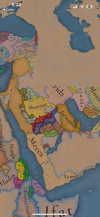Bring them back as they did exist in the 14 century as they were mentioned by ابن فضل الله العمري and أحمد القلقشندي
This is it In English
The earliest mention of the Mutayr tribe was by Ibn Fadlallah Al-Omari, a historian from the 7th century AH (700–769 AH). He mentioned them in the context of his discussion about the princes of Rabi’ah, the kings of the desert, as well as the tribes neighboring Mecca. Another reference to the name of Mutayr appears in the book Tuhfat Al-Mawdōd bi Sharh Manārāt Al-Sudūd by Ahmad Al-Qalqashandi, which is a historical book that confirms that Mutayr descends from the Ghaṭafān lineage.Plus the location Mutayr's original homelands were the highlands of northern Hejaz near Medina. At some point in the 17th century, however, the tribe began a large-scale migration eastwards into central Arabia, displacing many other Bedouin tribes in the area, such as Harb and 'Anizzah who were forced to move northwards after.
This is it In English
The earliest mention of the Mutayr tribe was by Ibn Fadlallah Al-Omari, a historian from the 7th century AH (700–769 AH). He mentioned them in the context of his discussion about the princes of Rabi’ah, the kings of the desert, as well as the tribes neighboring Mecca. Another reference to the name of Mutayr appears in the book Tuhfat Al-Mawdōd bi Sharh Manārāt Al-Sudūd by Ahmad Al-Qalqashandi, which is a historical book that confirms that Mutayr descends from the Ghaṭafān lineage.Plus the location Mutayr's original homelands were the highlands of northern Hejaz near Medina. At some point in the 17th century, however, the tribe began a large-scale migration eastwards into central Arabia, displacing many other Bedouin tribes in the area, such as Harb and 'Anizzah who were forced to move northwards after.
Attachments
Last edited:
- 109
- 20
- 9
- 6
- 6
- 5








